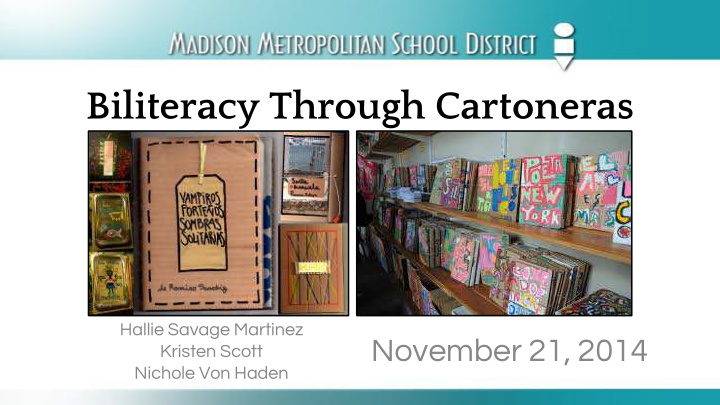



Biliteracy Through Cartoneras Hallie Savage Martinez November 21, 2014 Kristen Scott Nichole Von Haden
Inclusion At your table, introduce yourselves, and share: ❖ Where you are from ❖ What you teach ❖ What you hope to learn today
Integration As a group, define “integrated curriculum” as it applies to your work. Choose a volunteer to share a summary of your conversation.
Objective I understand the process of designing standards-based, thematic units of study aimed at developing biliteracy and language. ★ I can apply this biliteracy framework and authentic performance- based assessment to an existing, or potential, curricular unit. ★ I can connect the cartonera publishing process, subsequent extension activities as authentic, performance-based assessments.
Agenda ★ Set the stage: background on our work and possible connections to yours ★ Walk through the planning and teaching of a model unit on biliteracy ★ Reflect ★ Feedback
Biliteracy Through Cartoneras
Cartoneras The Cartonera Project What: In this unit, students will be writing narratives to tell the story of a cultural event that matters to them. How: Students will use cartoneras as a way to publish their stories. For whom: Students will display the cartoneras in their school/community library or bookstore. Extension: Published cartoneras can be sold in the community to raise funds for classroom activities or another specific philanthropic purpose.
Biliteracy Connections Spanish Language Arts English Language Arts ❖ based on authentic, informative text ❖ based on a fictional narrative text ❖ theme: La Semana Santa ❖ theme: La Semana Santa ❖ Guiding Question : How do I learn ❖ Guiding Question : How do I learn about myself and others through about myself and others through various kinds of text? various kinds of text?
Performance-Based Assessments Spanish Performance-Based Assessment: English Performance-Based Assessment: Students will plan, write, and publish a narrative to tell Students will plan, write, and present a news story their own story of a cultural event that matters to them. informing the public about their cultural event. Performance-based assessments should include REAL WORLD: G oals R oles A udience S ituations P roducts or P erformances S tandards [From: http://opi.mt.gov/pdf/CurriculumGuides/Curriculum-Development-Guide/GRASP.pdf]
Great Teaching Matters: Plan
Seven Norms of Collaboration • Pausing • Paraphrasing • Posing questions • Providing data • Putting ideas on the table • Paying attention to self and others • Presuming positive intentions The Adaptive School: Developing and Facilitating Collaborative Groups by Garmston and Wellman, p. 45.
Read and Reflect Read the sample English and Spanish Language Arts lesson plans for biliteracy. Discuss (with optional protocol): ★ How do oracy, reading, writing and cross-language connections work together to form a foundation for this unit? ★ Which example of these four types of connections is most interesting to you? ★ How can you use a similar framework with a unit you currently teach? Example: I noticed that narrative text (story) and informative text (newspaper article) were both used to engage students in learning about the Semana Santa event. A theme about which I teach is ecosystems. I wonder how I might incorporate a story about the rainforest with informational text about the rainforest to teach students about this type of ecosystem?
Each subject area addresses specific literacy and language proficiency standards Content Standards Language Standards ❖ Common Core State Standards ❖ WIDA (SALSA) Standards ❖ Common Core en español ❖ WIDA English Language Development (ELD) Standards
Time to Process: How Might This Framework Apply in Your Context? Take some time to begin completing your graphic organizer to generate some ideas for developing your own biliteracy, language-focused unit reflecting on the following questions: 1. What content standards and language standards do I use? 2. What theme could I address that would be of interest to my students? 3. What are some guiding questions I could use to address that theme? 4. What Spanish language and English language resources can I use? 5. What fiction and nonfiction resources can I use to help students understand the theme? 6. With whom might I collaborate to design this unit?
Planning for Collaboration Discuss: ★ What challenges might you encounter with this framework? ★ What changes might you make for your grade level or subject area? ★ How could you use this framework, or any other elements of this presentation, to collaborate with other teachers in your school? ★ What role might technology play in facilitating your collaboration efforts?
Great Teaching Matters: Reflect and Adjust Woven throughout this process, is a focus on Culturally and Linguistically Responsive practices. As you review this unit, what feedback can you provide us to reflect and adjust this particular unit to make sure we accommodate all six practices?
Thank you! Contact information: Hallie Savage-Martinez - hsavage@madison.k12.wi.us Kristen Scott - klscott@madison.k12.wi.us Nichole Von Haden - nvonhaden@madison.k12.wi.us
Recommend
More recommend